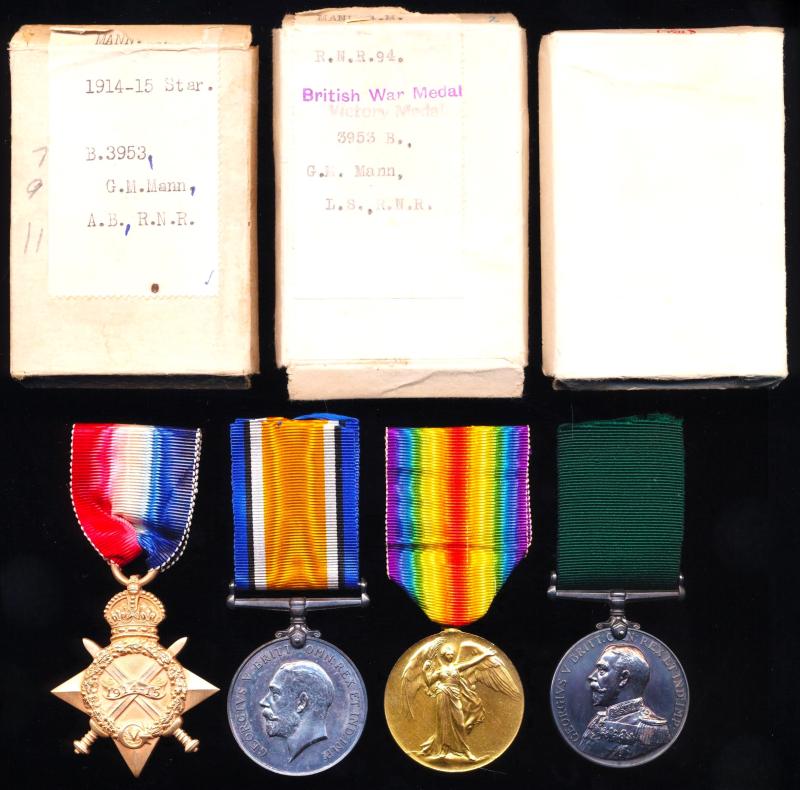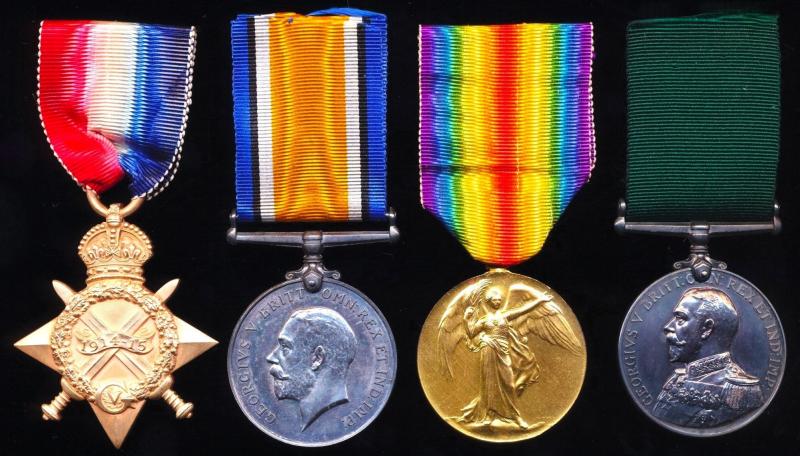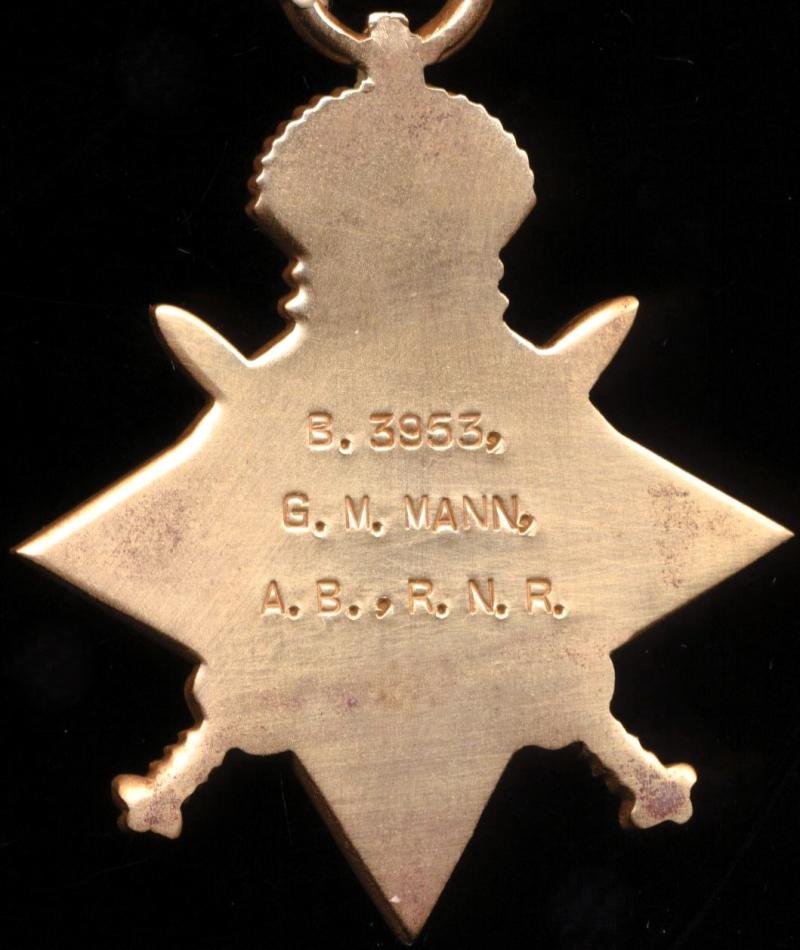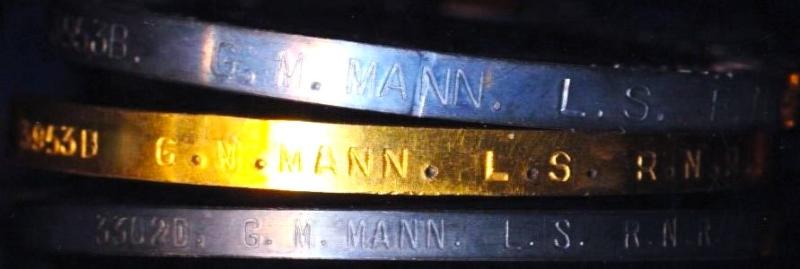A Shetlander from the Isle of Yell, Great War campaign medal and long service medal group of 4: Leading Seaman Gilbert Magnus Mann, Royal Naval Reserve late H.M.S. Achilles
- 1914-15 Star (B. 3953, G. M. Mann, A.B., R.N.R.)
- British War Medal. Silver issue (3953B. G. M. Mann, L.S. R.N.R.)
- Interallied Victory Medal (3953B. G. M. Mann, L.S. R.N.R.)
- Royal Naval Reserve LSGC. GV issue (33020. G. M. Mann. L.S. R.N.R.)
The medals sold together with:
- 3 x card boxes of issue, two of these named with name of medals on the lid.
Medals verification:
- 1914-15 Star: ADM 171/122
- British War Medal. Silver issue: ADM 171/122
- Interallied Victory Medal: ADM 171/122
- R.N.R. LSGC: ADM 171/71 awarded 11/03/26 presented to the recipient at Lerwick, Shetland
Gilbert Magnus Mann son of Peter Mann and Alice Mann was a native of Grimister, Isle of Yell, Shetland, where he was born on,1 October 1881, Gilbert first enlisted in the Royal Naval Reserve on, 1 January 1906. Prior to the Great War, Gilbert had been employed as a seaman, working variously on fishing vessels. After enrolment, James was initially rated 'Able Seaman' and later became 'Leading Seaman'. During the Great War, James is recorded to have served aboard the armoured-cruiser H.M.S. Achilles (Shetland's Roll of Honour and Roll of Service refers). After the Great War, Gilbert returned to Shetland, where he again became a seaman working in the fishing industry. His service records show that he was employed in the 'Inshore Fishing Industry' 1921-1923, followed by employment in 'Road Making' 1924, followed by work 'Crofting' which latter he did between 1925-1932. Gilbert Magnus Mann is recorded to have died at, Lerwick, Shetland on, 7 October 1939
H.M.S. Achilles: Achilles was ordered as part of the 1903–04 naval construction programme as the third of four armoured cruisers. She was laid down on 22 February 1904 at Elswick by Armstrong Whitworth. The ship was launched on 17 June 1905 and completed on 22 April 1907 at the cost of £1,191,103. Like her sister ships, she joined the 5th Cruiser Squadron in 1907, and made a port visit to Russia in 1908. The ship was later transferred to the 2nd Cruiser Squadron in 1909.9 Achilles, accompanied by her sister Cochrane, and three other armoured cruisers were sent to reinforce the defences of the Shetland Islands on 2 August 1914, days before the start of the First World War. She, and her squadron, was assigned to the Grand Fleet after the beginning of the war
Achilles missed the Battle of Jutland on 31 May 1916 because she was refitting. On the evening of 18 August, the Grand Fleet put to sea in response to a deciphered message that the High Seas Fleet, minus the II Battle Squadron, would be leaving harbour that night. The Germans planned to bombard the port of Sunderland on 19 August, with extensive reconnaissance provided by airships and submarines. The Germans broke off their planned attack to pursue a lone British battle squadron reported by an airship, which was in fact the Harwich Force under Commodore Tyrwhitt. Realising their mistake, the Germans then set course for home. During the Grand Fleet's sortie, Achilles spotted a U-boat. During another sortie by the High Seas Fleet on 18 October 1916, Achilles and three other armoured cruisers were ordered to patrol the northern end of the North Sea, between the approaches to Pentland Firth and Hardangerfjord in Norway, but they saw no German ships
On 16 March 1917, Achilles and the armed boarding steamer Dundee were patrolling north of the Shetland Islands when they encountered the disguised German auxiliary cruiser Leopard. The latter ship heaved to when commanded, but manoeuvred to prevent Dundee from boarding her and then fired two torpedoes which missed. Dundee retaliated by raking Leopard's stern, badly damaging the German ship and then Achilles opened fire herself. The German ship sank an hour later with no survivors. Achilles was transferred to the North America and West Indies Station in August 1917 for convoy escort duties, but returned to Britain for a refit between February and December 1918. Upon completion of this refit Achilles became a stoker's training ship at Chatham.The ship was sold for scrap on 9 May 1921
The recipients Royal Naval Reserve service records are extant and accessible at The National Archives
For a detailed summary of Shetland's contribution and experiences during the Great War, we would refer clients to the excellent PDF resource produced by the Shetland Library, by cutting and pasting below link / address:
https://www.shetland.gov.uk/downloads/file/1344/the-fighting-forces-secondary-resources-information-sheets-for-s1-s6
The medals all mostly pristine, and a choice condition group, to a Shetlander, from the Isle of Yell
Condition: Toned EF
Code: 24136







